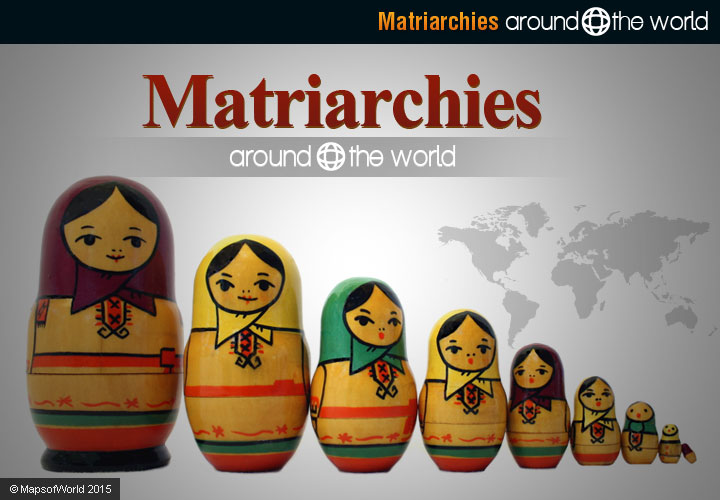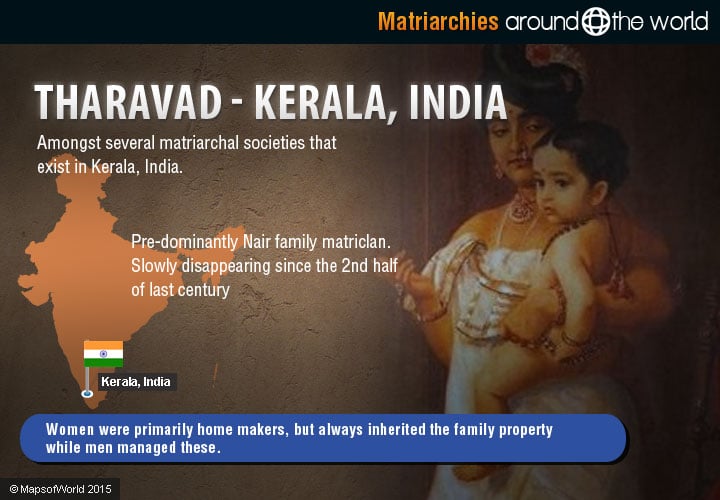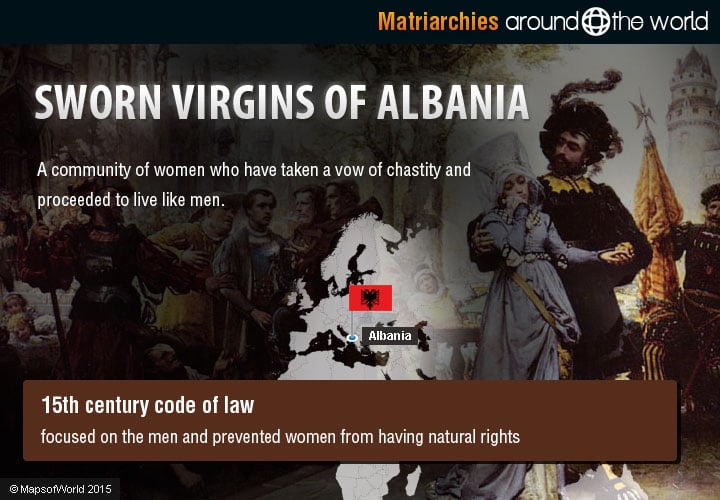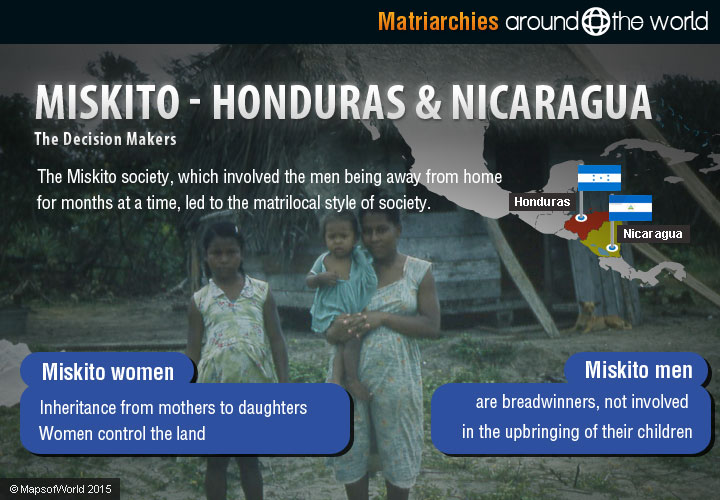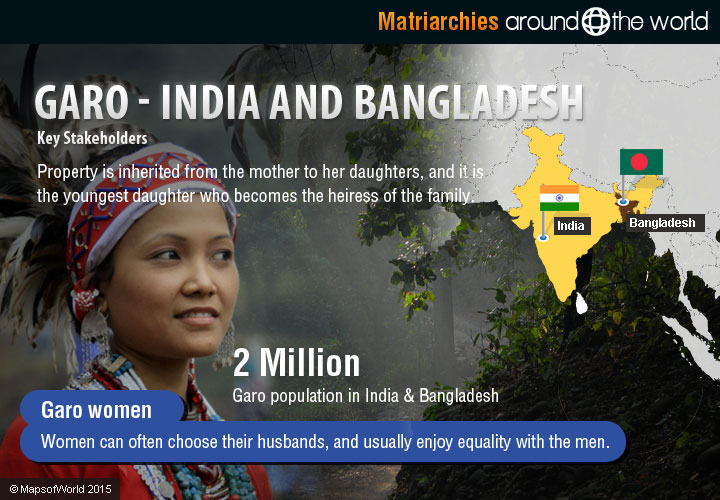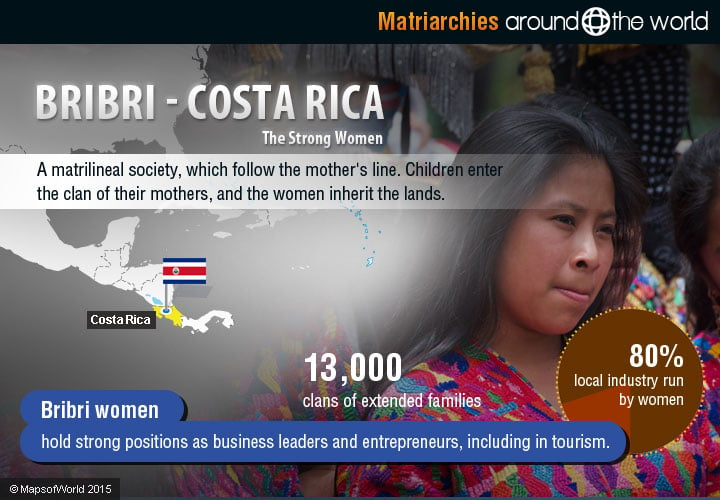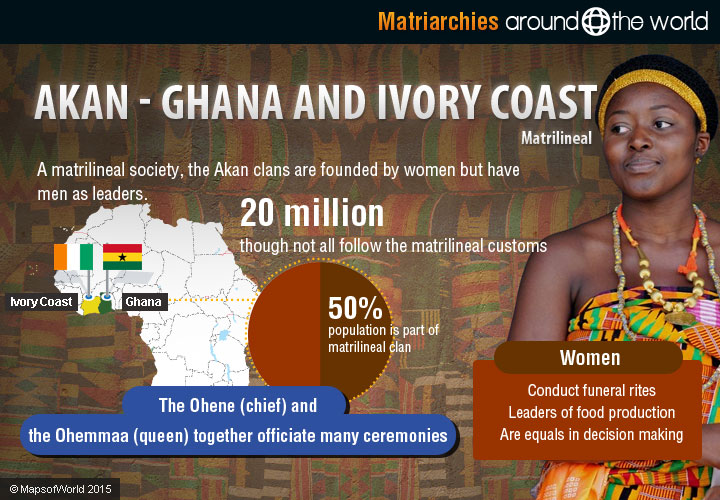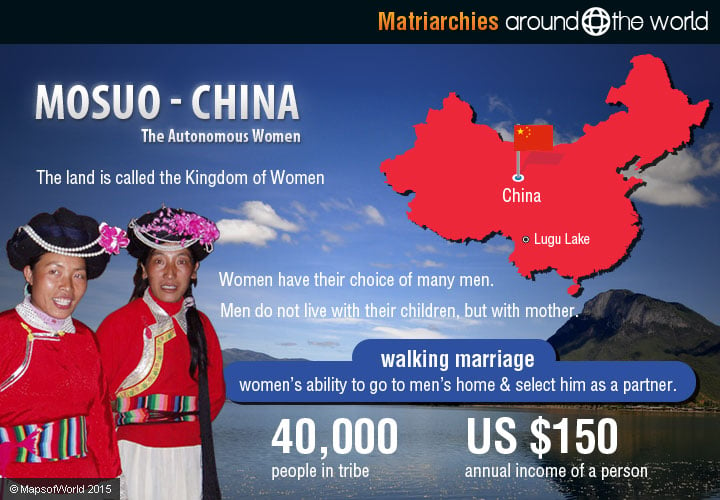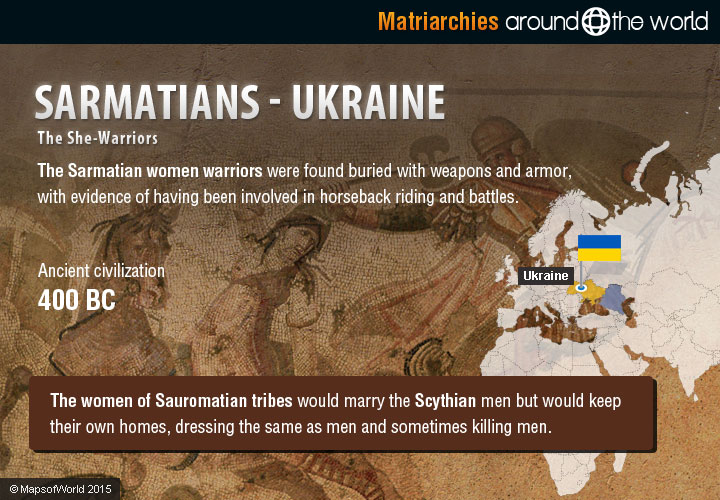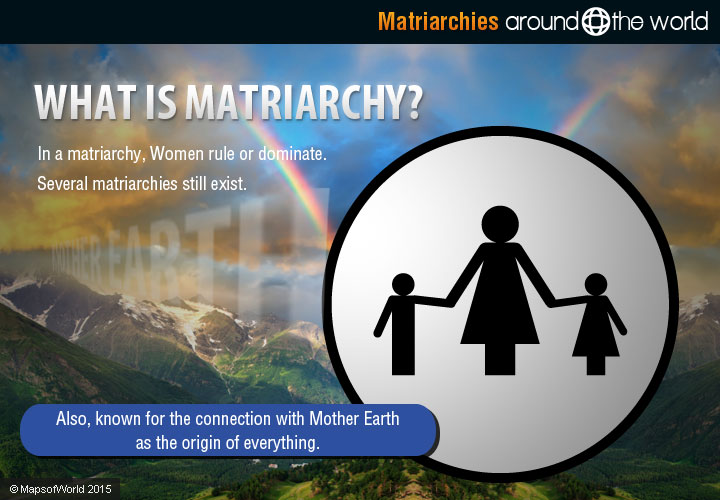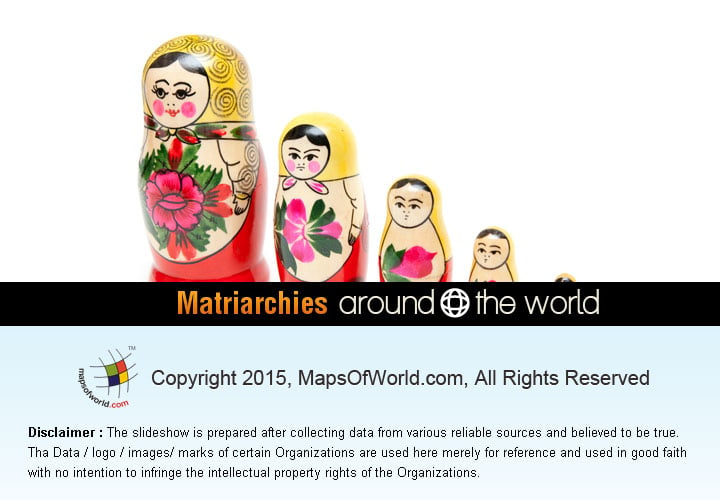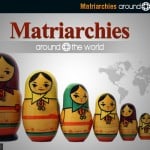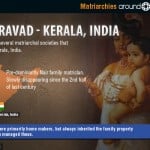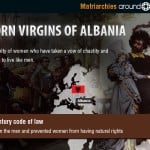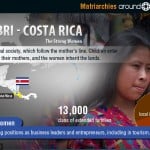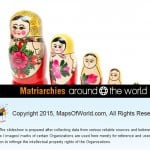Matriarchies Around the world
In celebration of International Women’s Day, here’s a look at the modern matriarchy, a showcase of matriarchies around the world.
There are several types of matriarchal societies, including the matrifocal family, or mother-centered families. Fathers may not always play a role in the upbringing of children. There are also matrilineal societies, in which ancestral lineage is traced through the mother’s line. Also characteristic of this type of society is that property is passed down through the mother’s line. These families also center on the mother’s side of the family, with men sometimes leaving their own family units to join their mother’s. The matriclan includes multiple generations of the mother’s line, as well as her male family members.
None of these types of societies necessarily involve a matriarch in the sense of a woman as political leader, and is not necessarily in opposition to patriarchy. Instead, the term matriarchy can be used to define woman- or mother-centered societies that are based on maternal values and principles, like nurturing and caretaking. Matriarchies can be found at the social level, the economical level, the political level, the spiritual and cultural level.
Matriarch is defined as follows –
Matriarch (noun): a woman who rules or dominates a family, group, or state; specifically: a mother who is head and ruler of her family and descendants (Merriam-Webster)
Another contributing factor to matriarchal societies is a connection with Mother Earth as the origins of everything, and the lands themselves. Matrilineal societies in which women are the landowners are tied to this concept.
Related to this are cultures with significant and important goddesses, such as the Greek Goddess of War, Athena, and the Roman one, Bellona, who are fierce female leaders. Similarly, the legendary Amazon women of Greek mythology were an entire race of women warriors, in which men were not a significant part of the society.
The Mosuo, China
One of the best known examples of a matrilineal society is the Mosou, a tribe of about 40,000 living near Lugu Lake in the Himalayas of southwestern China. In the land known as the Kingdom of Women, inheritance is passed down the female line (lineage is traced through women) and women have their choice of many men. There are no marriages as we know them: women can choose their partners, the men do not typically live with their children, but live in their own mother’s household.
The Mosuo have something known as a “walking marriage,” named for the ability of a woman to walk to the home of the man, selecting him as her partner. There is no stigma against women having multiple partners. Children take their mother’s name and the men may not be involved in their upbringing. There’s no word in the local language for father or husband.
Women in the Mosuo have more power and autonomy in several ways. They take care of labor in the home, because historically the men were involved in trade and often away. Women dominate business decisions, though men are dominant in politics. The society is an agrarian culture, with annual incomes as low as US $150, though they are typically self-sufficient.
Minangkabau, Indonesia
The Minangkabau of West Sumatra, Indonesia are a community of more than five million, which makes them the world’s largest matrilineal society. The Minangkabau make up around 3% of Indonesia’s population of 245 million. This matrilineal society dictates that property (high inheritance) is bequeathed from mother to daughter, while low inheritance, like income is passed from the father to his children, and sons get double. While this has traditionally given women the bigger advantage, modern lifestyles are moving toward low inheritance as the more powerful type of inheritance. Lineage is traced through the mother’s line and the mother is the head of the family. Males are given away during the marriage ceremony, escorted to the woman’s home by his female family members.
In the home, women have their own rooms, and men stay in men’s quarters from the age of 10. However, a man is the clan chief, though women select the chief and are able to remove him. Both women and men share in decision making, and there is a sense of equality. Girls are cherished and hoped for by pregnant mothers.
The society is based on Islamic and animist traditions, and the adat – local customs and traditions. A man moves into his wife’s home when they get married, but the Minangkabau follow traditional gender roles with women as the masters of the domestic sphere, and men as political and religious leaders. Power and authority is shared, with men as the spokesman of the family and the women sharing in the power, partly because of their ownership of property. The defined roles of the system make it so women and men are not in competition.
The woman is seen as a connection between present, past, and future, and is seen as continuity, with the pregnant woman holding the future within her.
Akan, Ghana and Ivory Coast
A matrilineal society in Ghana and the Ivory Coast, the Akan clans are founded by women but have men in leadership. The community has a population of about 20 million, though not all follow the matrilineal customs. About half the population of Ghana is part of a matrilineal clan. Both economy and politics follow matrilineal lines. The clan-based community is made up of matriclans, with family units selected by the line of the mother, living in the abusa framework of unbroken extended family homes.
The community has elected traditional elders, the Ohene, or chief, and the Ohemmaa, the queen mother who officiate many ceremonies. Women conduct funeral rites, and undergo special rites of passage during puberty. Women also retain independence, not becoming a member of the husband’s family in marriage, though she typically takes the man’s last name. The matrilineal inheritance also allows women to remain economically independent. Additionally, women are typically leaders of food production, leading the industries of agriculture, fishing, and commerce. While there may be some subordination of women on the surface, women are typically equals in decision making behind the scenes.
Bribri, Costa Rica
Located in Talamanca, Costa Rica, the Bribri is a matrilineal, clan-based society of up to 13,000 clans of extended families, which follow the mother’s line. Children enter the clan of their mothers, and the women inherit the lands. Knowledge and tradition are passed down by the grandmother. The agrarian society also sees the special connection of women to Mother Nature. Bribri women are traditionally the managers of swine, with about 80% of the local industry run by women. Women also hold strong positions as business leaders and entrepreneurs, including in tourism.
Though men take on specific roles, including the awa (shaman) and the oko, ritual leaders, the women have their own special roles as the ones who prepare the sacred cacao for these rituals.
Garo
The Garo people of India and Bangladesh are a matrilineal society with a population of up to 2 million. The largest populations of Garo are located in Dhaka Division of Bangladesh (200,000) and Tripura, India (6,000).
In Garo society, property is inherited from the mother to her daughters, and it is the youngest daughter who becomes the heiress of the family. Boys move out of their family’s home and into a dorm around puberty, and when they marry, the men move into their wife’s home. Women can often choose their husbands, and usually enjoy equality with the men.
Despite the female ownership of property, men still dominate its management as well as that of society. Women in the villages are gatherers in the forests, while women who work in cities bring their income back home to their families.
Nagovisi, New Guinea
The Nagovisi community of South Bougainville, New Guinea is matrilineal with matriclans. The women of the Nagovisi hold positions of authority and power, traditionally in regards to the cultivation of their gardens. These gardens are the woman’s sphere, and are inherited by daughters. The community is largely based on crop cultivation. With this control of the food, like sweet potatoes and coconuts, woman may remain independent and men are dependent on the women for that food.
The man eating the woman’s food is a symbol of their marriage, and if he were to stop, it would be a sign of divorce. Men typically move into the woman’s family for marriage, and the women are the breadwinners. Men take care of the clearing of the lands, but typically follow the instructions of the woman.
Tuareg – Niger, Mali, Burkina Faso
The Tuareg are nomadic Berber people of North Africa of about 2 million, especially in the Sahara regions. The largest populations of Taureg are located in Niger (790,000), Mali (450,000), Algeria (up to 150,000), and Burkina Faso (30,000). The Tuareg stand out as a community for their reversal of dress code, compared to many other Islamic societies, as part of the Maliki sect. It is the Tuareg men who wear the Tagelmust, or indigo veils called Alasho to cover their faces, while the women do not. Men wear both turbans and veils once they reach maturity at age 25, while the women typically wear a head scarf. The distinctive indigo veils have given the Tuareg the nickname, the Blue People.
Women in the Tuareg community are held in high regard and respect, and enjoy a degree of independence. The Tuareg society is matrilineal, in that the inheritance passes through the female’s line. The female elders are also important figures in the society, in charge of child naming ceremonies. The core of the society is the woman, while the male dominates the external realm.
The Tuareg origin story also makes the culture unique – women were created first, before men, but that the two are complementary.
Miskito – Honduras, and Nicaragua
The Miskito people are native to Honduras and Nicaragua and have an interesting gender dynamic in their culture. The structure of the society of the Miskito, which involved the men being away from home for months at a time, led to the matrilocal style of society. Though men are typically breadwinners, the women are the decision makers, including decisions involving finances. The society is also matrilineal, with inheritance passing from mothers to their daughters. Though the men work the land, the women control it. Men are also not always involved in the upbringing of their children, and instead, the children are raised by the matrilocal family. Women in the Miskito society become the elders who take on an advisory role in the community.
Sarmatians – Ukraine and Northern Russia
“They [Sarmatian women] have no right breasts…for while they are yet babies their mothers make red-hot a bronze instrument constructed for this very purpose and apply it to the right breast and cauterize it, so that its growth is arrested, and all its strength and bulk are diverted to the right shoulder and right arm.” – Hippocrates
The Sarmatian people were an ancient civilization from about 400 BC, which featured warrior women who were found buried with weapons and armor, with evidence of having been involved in horseback riding and battles. The Sarmatian and Sauromatian people may have been the basis for the Ancient Greek mythological Amazon women, and legend has it they were formed from intermixing of the Amazons and the Scythians. The women of Sauromatian tribes would marry the Scythian men but would keep their own homes, dressing the same as men and sometimes killing men.
Sworn Virgins of Albania
The Sworn Virgins of Albania are a community of women who have taken a vow of chastity and proceeded to live like men. The practice was inspired by the Kanun, a code of law that dates back to the 15th century, which was focused on the men and prevented women from having natural rights. To get around this, women became sworn virgins so that they would be able to gain the same rights as men, including working, drinking alcohol, maintaining a household, singing, and socializing with men.
Becoming a sworn virgin was also the only way to get out of an arranged marriage without dishonor, and the only way to receive inheritance. The practice is dying out, as women have achieved greater independence and it is not necessary, and the last of the Sworn Virgins are mostly over 60 years old.
Tharavad – Kerala
Tharavad is amongst several matriarchal societies that exist in Kerala, India. This is a pre-dominantly Nair family matriclan, which has slowly disappeared owing to the collapse of the feudal order in the 2nd half of last century. In this matriarchy that existed for centuries in Kerala, women were primarily home makers, but always inherited the family property while men managed these.
Marumakkathayam was the system where the inheritance was passed on matrilineally. This was codified in 1932 and it ran under the Madras Malabar Act as Malabar was at that time a part of Madras presidency under the British Empire rule. In 1975, this form of inheritance was abolished by the local government.
Read More
- Most Expensive Cheese around the World
- Wines and Vineyards Around the World
- Drinks To Try Around the World
- Dance Forms Around the World
- Christmas Myths and Legends
- How to Say Hello around the World?
- The Dying Art of Hand Writing
- China to do away with one-child policy
- All you need to know about Halloween
- Top 10 Favorite Wines
- Ten Most Relished Foods Around the World
- Tribes Around the World
- Food Festivals Around the World
- Gay Laws Around the World
- Matriarchy Around the World
- Royal Families Around the World


